When I started with web development a few years ago, Vim was my first choice of text editor. It was easy to work with and I could get the basics done without much hassle. Also, many developers like terminal based text editors because they get the same environment in both their local development machines and remote servers. In spite of the “Vim vs Emacs” debate out there, about a year ago I decided to try out a native text editor and Twitter was abuzz with one of them (no prizes for the guessing which one.)
The creators of Sublime Text say it’s a text editor you’ll fall in love with and, having worked with it for almost a year now, I must say I completely agree with them. It has an untimed trial, and a licence for a single user costs $70. If you spend most of your day working with a text editor, I would say it’s a worthy investment!
What makes Sublime Text even better is its extensibility. So, here’s a look at the plugins that make an already wonderful editor truly Sublime.
1. Package Control
One way of installing Sublime Text plugins is by downloading files and copying them to the packages directory. However, you should go through that process exactly once, because there exists a plugin called Package Control: a package manager, enabling you to install other plugins without leaving Sublime Text. It’s like apt-get for Ubuntu, pip for Python and npm for node.js.
Follow the installation instructions here and you won’t have to install another plugin manually ever again.
To verify that it’s been correctly installed, press Ctrl/Cmd + Shift + p and type in ‘package control’ — you should be able to view a list of options.
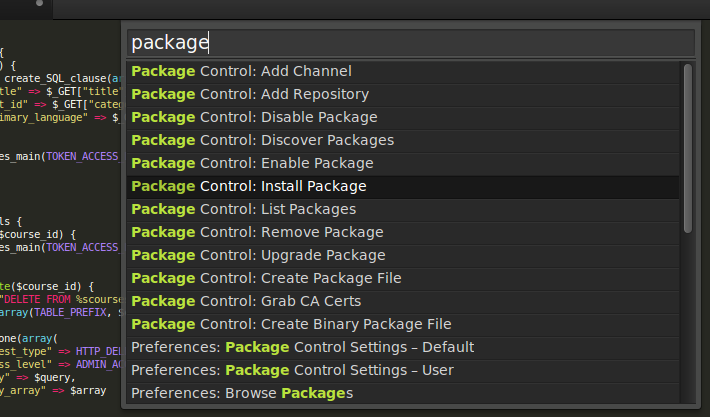
2. Git
These days, more often than not, you are going to work with a version control software, and the most popular VCS is Git. Are you tired of saving your text files and switching back to the terminal to run a few Git commands. Wouldn’t it be nice if you could execute Git commands from the text editor itself? Install the Git plugin and get more done in less time!
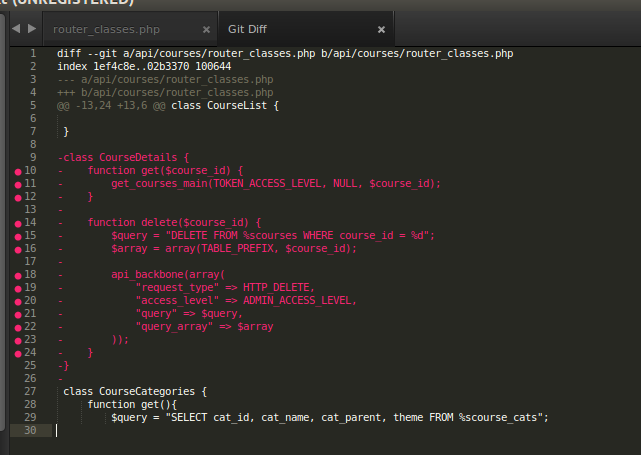
3. GitGutter
Although you can run Git commands from within Sublime Text, why check the differences in a file from the last commit by running a separate command when you can view it in real time?
With GitGutter, you can see which lines have been added, deleted or modified in the gutter.
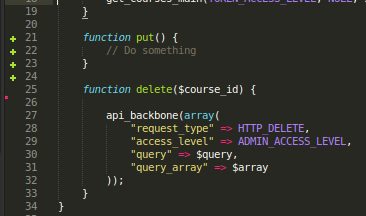
4. Emmet
Emmet is a useful plugin that saves time by making you write less, thus increasing your productivity. Emmet is available for other text editors like Notepad++ and Eclipse.
There are a lot of things that you can accomplish with Emmet, but I will just tell you my favorite here. Type html:5 and press Ctrl/Cmd + e, and it is expanded to a basic HTML 5 page template. Simple!
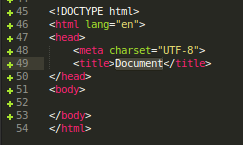
5. AllAutocomplete
Sublime Text’s default autocomplete considers words that are present in the current file only. The AllAutocomplete plug-in, however, searches all open files to find matches while suggesting words.
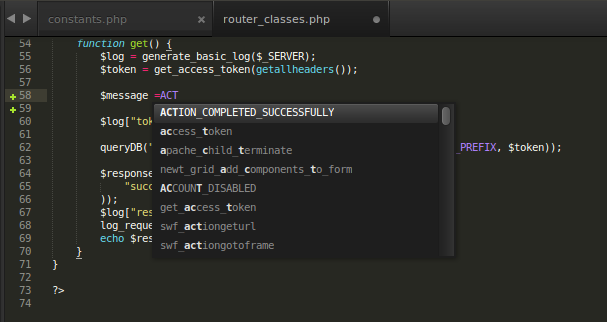
6. Terminal
Just in case you want to open a terminal in the directory of your current file, this plugin can be of use. However, by default, it sets Ctrl/Cmd + Shift + t as the shortcut for opening the terminal, which is also the shortcut to open the last closed file. You should change either of the shortcuts to be able to use both functionalities!
7. SublimeREPL
This is probably the most useful plugin for programmers. SublimeREPL lets you run an interpreter of a range of languages (NodeJS, Python, Ruby, Scala and Haskell to name a few) right inside Sublime Text. Let us run a Python interpreter and see if it works. Perform some list checks and computed 48 raised to the power 100.

8. ColorPicker
Usually, if you want to use a color picker you probably open Photoshop or GIMP and use the built-in color picker there. The ColorPicker plugin lets you use a color picker within Sublime Text! After installation, just press Ctrl/Cmd + Shift + c.
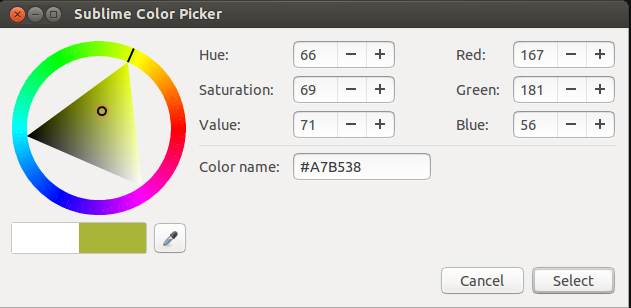
9. MarkdownPreview
Although many developers prefer to create Markdown files in the cloud (GitHub Gists, StackEdit, Markable), this is for the ‘old school’ writers who prefer to keep their files locally. Although MarkdownPreview is primarily to preview Markdown files, you can go one step further and install MarkdownEditing, which gives you proper color highlighting.
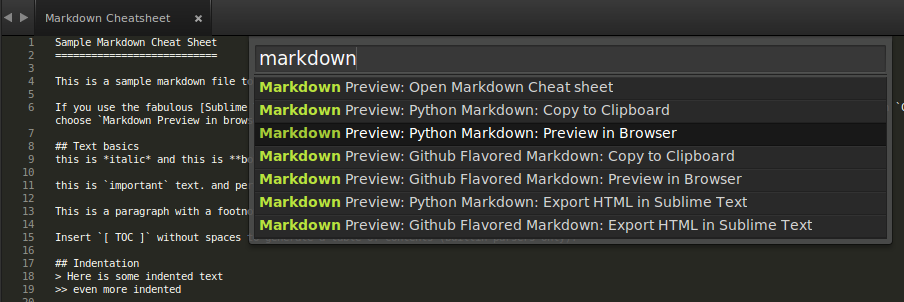
10. DocBlockr
If you follow coding guidelines strictly, this is one plugin that makes your task easier. DocBlokr helps you in creating proper comments for your code, by parsing the functions, parameters, variables, and automatically adding the basic items. Start with “/**” and DocBlockr does the rest for you. For instance, check how DocBlockr makes my life easier by creating a format for me to fill based on my comment.
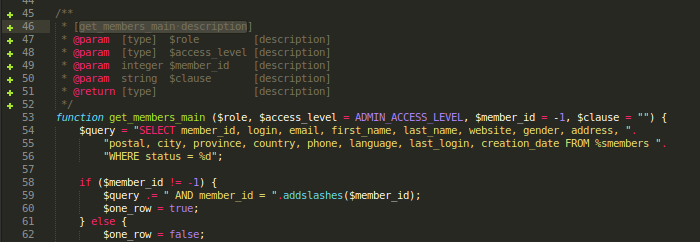
With this, we come to the end of our list of plugins to boost your productivity. Did we miss out any important ones? Do let us know your favorites in the comments below.
You may also be interested in our Working with Sublime Text video.
Frequently Asked Questions (FAQs) about Sublime Text Plugins for Full Stack Developers
What are the benefits of using Sublime Text plugins for full stack development?
Sublime Text plugins offer a range of benefits for full stack developers. They can significantly enhance productivity by automating repetitive tasks, providing shortcuts, and offering advanced features not available in the base editor. For instance, plugins like Emmet can speed up HTML/CSS coding, while GitGutter can show git diff information right in the editor. They can also improve code readability and debugging, with plugins like SublimeLinter providing real-time linting and BracketHighlighter enhancing bracket and tag visibility.
How do I install Sublime Text plugins?
Sublime Text plugins can be installed via Package Control, the package manager for Sublime Text. First, you need to install Package Control. Once installed, you can search for and install plugins directly from within Sublime Text. Simply open the command palette (Ctrl+Shift+P or Cmd+Shift+P), type ‘Install Package’, and select the plugin you want to install.
Can I create my own Sublime Text plugins?
Yes, you can create your own Sublime Text plugins. Sublime Text plugins are written in Python, so you’ll need some knowledge of Python programming. The Sublime Text API provides a range of functions for interacting with the editor, and there are numerous resources and tutorials available online to help you get started with plugin development.
Are there any recommended Sublime Text plugins for JavaScript development?
There are several Sublime Text plugins that can enhance JavaScript development. For instance, SublimeLinter with the JSHint extension can provide real-time linting for JavaScript, while JSFormat can automatically format your JavaScript code. Other useful plugins include DocBlockr for generating comment blocks, and Babel for ES6 and React JSX syntax support.
How do I update Sublime Text plugins?
Sublime Text plugins can be updated via Package Control. Open the command palette (Ctrl+Shift+P or Cmd+Shift+P), type ‘Upgrade Package’, and select the plugin you want to update. If there are updates available, Package Control will download and install them automatically.
Can I use Sublime Text plugins with other text editors?
Sublime Text plugins are specifically designed for use with Sublime Text, and cannot be used with other text editors. However, many popular Sublime Text plugins have equivalents or similar functionality available for other text editors like Atom or Visual Studio Code.
What are some Sublime Text plugins for improving code readability?
Plugins like BracketHighlighter and ColorHighlighter can significantly improve code readability in Sublime Text. BracketHighlighter enhances bracket and tag visibility, while ColorHighlighter displays the actual color for color codes in your CSS or other files. Another useful plugin is TrailingSpaces, which highlights and removes unnecessary trailing spaces.
How do I uninstall Sublime Text plugins?
Sublime Text plugins can be uninstalled via Package Control. Open the command palette (Ctrl+Shift+P or Cmd+Shift+P), type ‘Remove Package’, and select the plugin you want to uninstall. Package Control will then remove the plugin and its files from your Sublime Text installation.
Are there any Sublime Text plugins for Python development?
Yes, there are several Sublime Text plugins that can enhance Python development. Anaconda provides a full-featured Python development environment within Sublime Text, while SublimeREPL allows you to run an interactive Python interpreter in a Sublime Text window. Other useful plugins include Python Auto-Complete for automatic completion of Python code, and Djaneiro for Django template support.
Can I use Sublime Text plugins offline?
Yes, once installed, most Sublime Text plugins can be used offline. However, you will need an internet connection to install or update plugins via Package Control. Some plugins may also require an internet connection for certain features, such as accessing online documentation or APIs.
 Shaumik Daityari
Shaumik DaityariShaumik is a data analyst by day, and a comic book enthusiast by night (or maybe, he's Batman?) Shaumik has been writing tutorials and creating screencasts for over five years. When not working, he's busy automating mundane daily tasks through meticulously written scripts!




